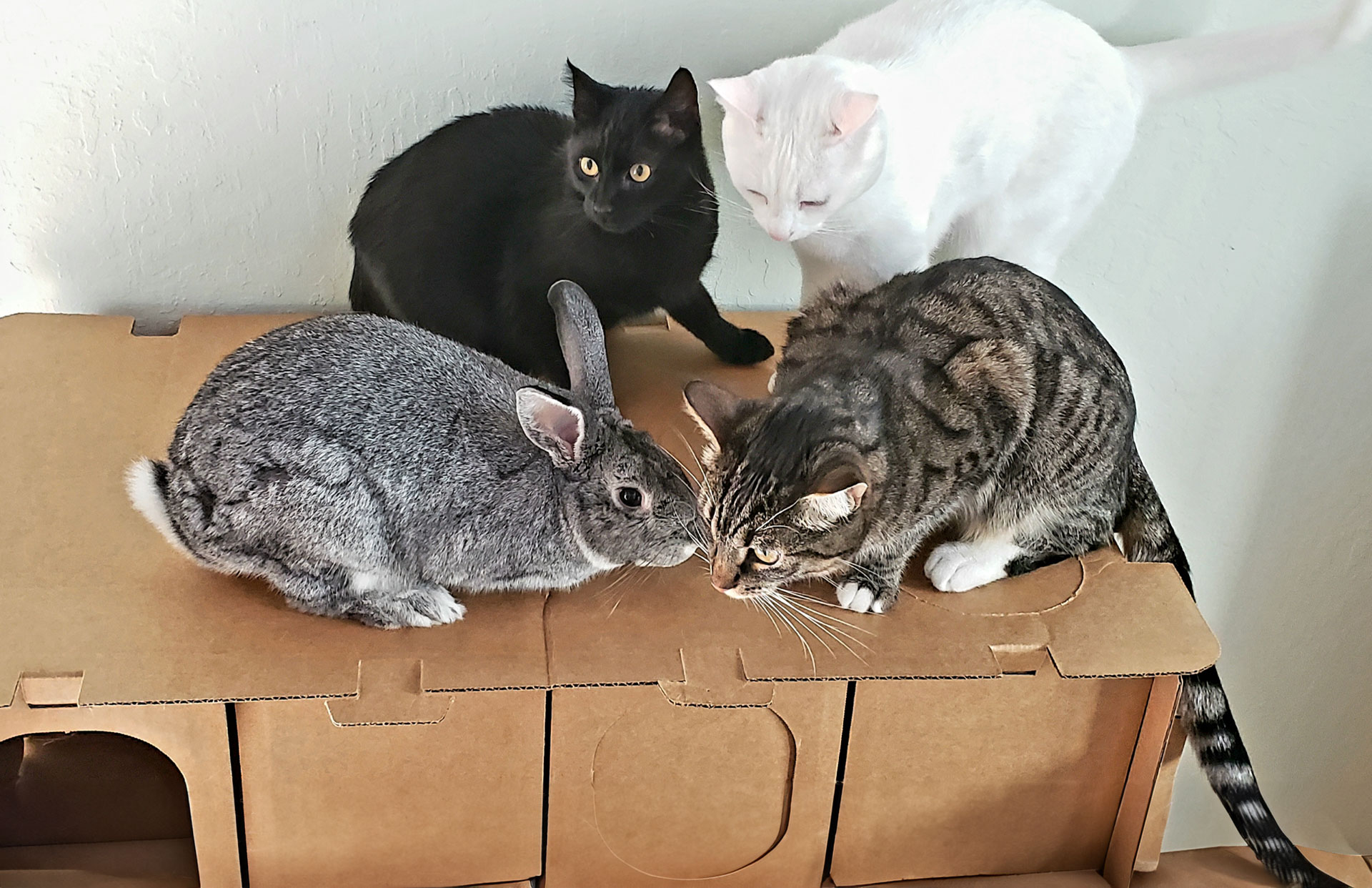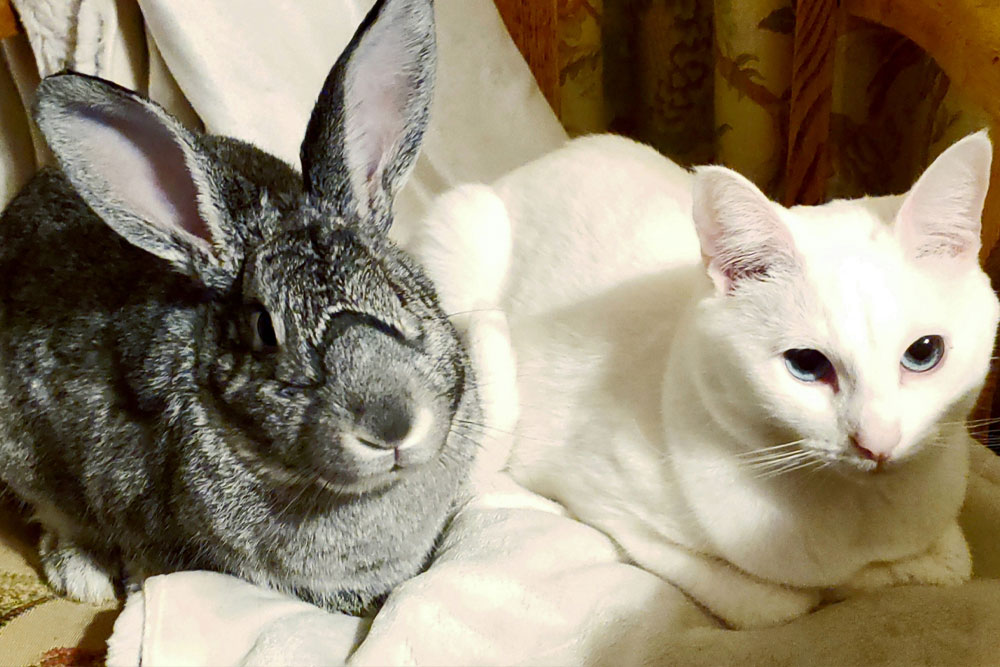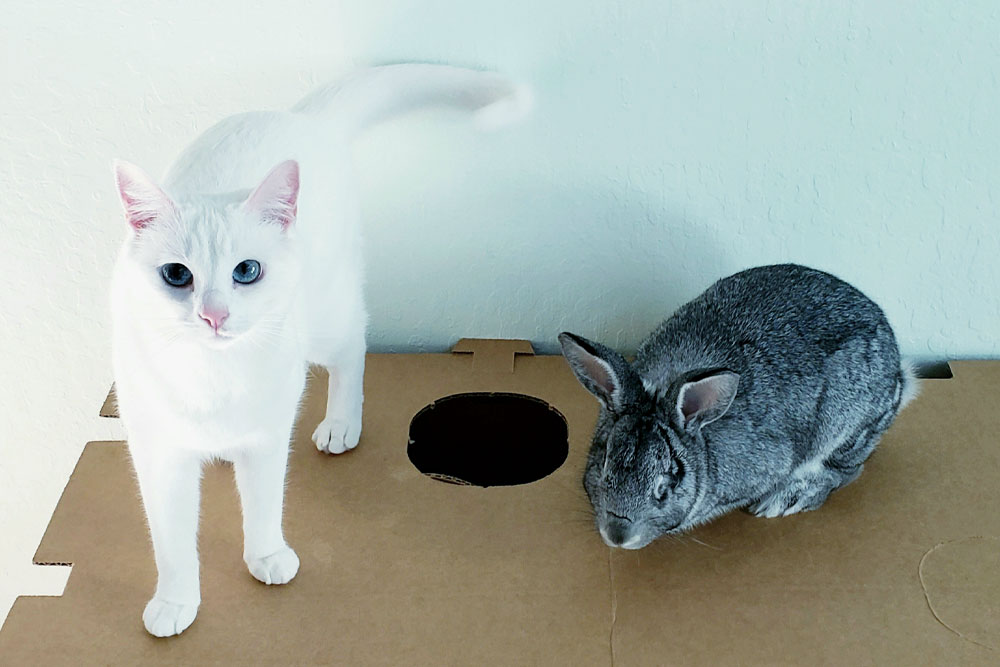How I Made It Work
With only experience caring for cats, birds, dogs, and fish, I recently fostered and then adopted a rabbit from House Rabbit Society whom I named Bonbon. With my intense admiration for animals, it was a long-overdue decision. As much as I wanted to rescue a bunny, my primary hesitation revolved around cohabitation with my cats. Never having cared for a rabbit, I was trepidatious about introducing one to my six-cat brood. Proceeding with caution, I decided to foster the adorable bunny for one month. Just over three weeks into the trial period, my heart ached at the thought of returning him. I was officially attached. Now, I had the daunting task of making both the cats and the rabbit comfortable and happy in my home.
Reading much literature about rabbits brought me to the conclusion they aren’t very different from cats in their primary nature. They can both be skittish, require personal space, enjoy playing, need private indoor bathroom facilities, respond well to consistent schedules, like to experience human interaction and be petted, are social and pack animals, and need similar health management.

Providing for the cats in these eight areas was easy after all my years of experience but now I had to figure out how to provide for my rabbit. I was hopeful that if the bunny’s needs were met, he would respond by feeling safe and eventually happy and not behave aggressively toward or be intimidated by my cats.

During the adjustment period, I offered Bonbon a large enclosure with three sections: a litter box with hanging hay dispenser, a flat, roomy area, and a burrowing tunnel for hiding. The door was only closed overnight and brief daytime periods when no one was home. Before our new bunny was brought home, the cats investigated the rabbit enclosure. Realizing it was nothing exciting, they accepted it just like they would another piece of furniture. When Bonbon came home, I showed him the habitat immediately, with the cats closed off from the area. He explored it, chinned it, and began eating hay. My research indicated those were all good signs. The area had also been outfitted with a bowl for water, bowl for veggies, a stuffed animal, apple sticks, and a soft fleece blanket, all of which were purchased just for him. I thought it best he not share things in his personal space with the cats until I knew they got along.
Next came introducing the cats to the room where Bonbon and his habitat were. I knew this would possibly take a long time, so patience was a necessity. I let one cat at a time walk into the room, beginning with my most curious and friendly young feline. After she left, I let the next cat in to investigate, and so on. Each one cautiously approached Bonbon’s area, sniffed the perimeter, and walked away. It was obvious they didn’t feel threatened. The rabbit, however, gave two small thumps when my five-month-old kitten walked near. I think the two older cats read the bunny’s body language well, but the kitten needed a little clearer message. Upon hearing the thumps, he backed away, which meant he understood. I knew if neither species felt threatened by one another, they were more likely to accept each other. During this timeframe, Bonbon’s door was closed. He enjoyed his privacy and accepted that space as only his.
Cats must have space and toys and food that are individually theirs. The same holds true for rabbits. Once I felt certain that my bunny and my cats knew the rabbit enclosure was only for him, I opened the door. I had placed an upholstered small animal bed which the cats had frequented adjacent to his habitat. It had their smell on it, which I wanted him to become familiar with. Bunnies are similar to cats and dogs in that their noses and ears play more important sensory roles than do their eyes. Accepting each other’s scents would be an important milestone.
Since Bonbon and three of the cats were close in age (around a year old), I was hoping their instinct to play would help instigate the familiarizing process. When both species were fully rested, had nice, full tummies from breakfast, and were ready for activity, I introduced some toys. Balls with bells inside, wand toys, and catnip-filled baubles were scattered around the room. The cats eagerly engaged in play while Bonbon watched from inside his area. Either his curiosity or desire to play got the better of him, and he hopped over to a toy. While examining the toy, one of the cats snuck up on him from behind and sniffed him. What happened next was simply magical; the cat and the bunny touched noses and began to nudge the toy together! Then another cat came and joined in. The kitten, the previous recipient of the two thumps, kept his distance while observing. After this positive interaction, I gathered up those toys and exchanged them for different ones. A large build-it-yourself cardboard condo complex sealed their cohabitation. It was two stories tall with openings on both sides. I stuffed it with small fun toys including thick yarn, straws, toilet paper tubes, wadded crinkle paper, and plastic spoons. Neither cats nor bunny could resist the temptation to go inside this new box. Before they knew it, they were playing games of hide and seek, chase, and grab the toy together! The cats were most interested in jumping on top of the box and trying to figure out what was inside making it move. Bonbon enjoyed jumping about, which created intriguing noises for the cats to figure out. They were equally captivated by the contraption and worked as a sort of team to conquer it.


Each day I changed out the toys and moved the condo around the room to different locations. The cats and bunny alike love the same toys in new places. Next, I introduced a kitten scratching post into the mix. It had been dearly loved by all three cats. They showed Bonbon how to jump into the little ‘den’ on the top and how to rub against the dangling sisal-covered scratcher and, most importantly for Bonbon, how to burrow through the small carpeted tunnel. The cats appeared to like this new creature enjoying their belongings while the bunny liked having those new luxuries.
Human reassurance was key during this experience. I made sure to dote on each of them even more than usual. All animals are special and deserve nothing short of royal treatment. Making each individually feel secure and safe allows them to accept others into their pack. After nine weeks of having my darling rabbit Bonbon, I can emphatically state he has been accepted as part of our combined human-animal family. We have six cats, one dog, one rabbit, and one bird. Each animal has a unique personality and each species has unique natures, but all share one common denominator: love.
Reviewed by HRS staff
Author: Heather Woodiwiss
Photo Credit: Heather Woodiwiss
Journal Issue: House Rabbit Journal, Summer 2020
Sign up to Our Newsletter!
Sign up for web update alerts and our monthly e-newsletter
to stay current on HRS, our Chapters, and info for your bunny.




